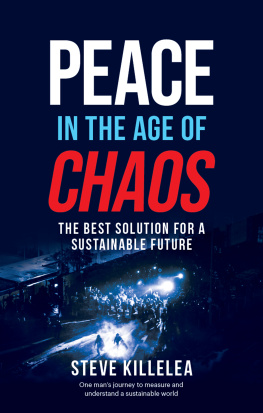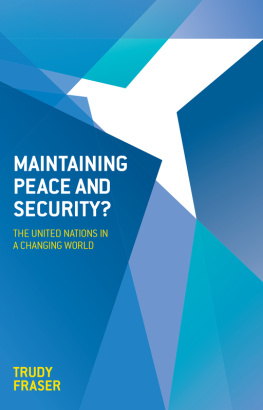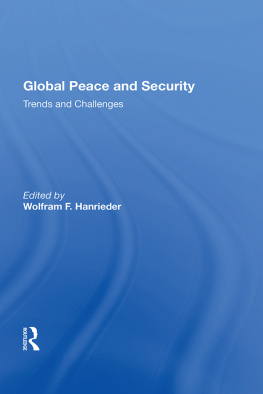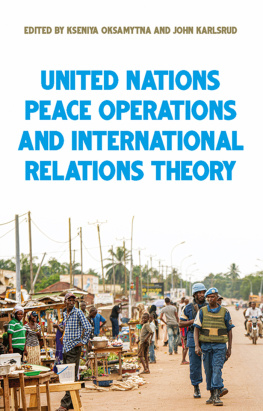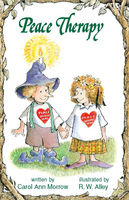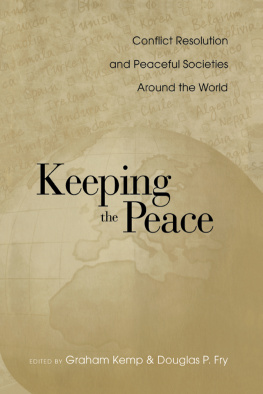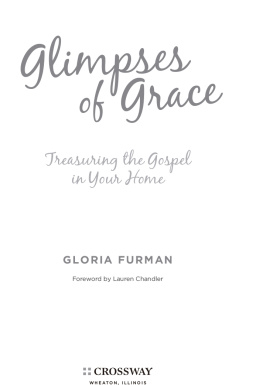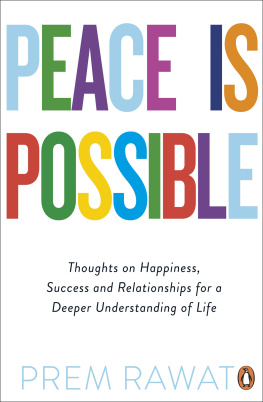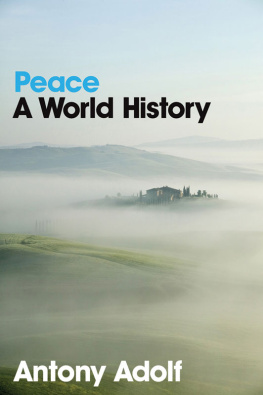About the author
Steve Killelea is the founder of the internationally renowned global think tank the Institute for Economics and Peace (IEP). He is regularly quoted in the media on subjects ranging from terrorism to conflict and is also a sought-after international speaker. His funding of the IEP was recognised as one of the 50 most impactful philanthropic gifts in Australias history by a coalition of Australian Foundations in 2013. He has been recognised as one of the worlds 100 most influential people on reducing armed violence. In acknowledgment of Steves deep commitment to peace, he has twice been nominated for the Nobel Peace Prize.
Contents
Like so many people, I look at the world and realise that our leaders and our institutions are out of step with the needs of our times. Many hold attitudes that are outdated or, worse, they are undoing what little positive action is being undertaken. We are all enmeshed in our ecological and societal systems and dependent on them for our very survival. Yet the rapid pace of change in the world is causing these systems to decay. It is estimated that the biomass of all mammals on the planet comprises of 60 per cent livestock, 36 per cent human and only four per cent is all other mammals. This is clearly unsustainable.
Imagine that all of the life on the planet is a tapestry, beautifully woven, intricate and exquisite in detail. Now imagine your role in relation to the tapestry. Is it to continue to weave and enhance it with loving care, or to take to it with a pair of scissors, indiscriminately cutting it? Put simply, we would all hope that our lives have a positive impact, but our collective actions can hardly be seen that way. We are simply shredding the tapestry of our existence.
More through luck than anything else, my own personal journey has provided me with insights and a strategy that can offer a new and original approach to alleviating and helping to solve many of the intractable problems that humanity is facing.
I am what some people would call a self-made man, successful in business and other pursuits as well. But I do not necessarily feel self-made. Much of my success has come about by chance. Those chances could have easily fallen to others, but what really sets me apart are the circumstances surrounding me. I have worked hard, but as far as I can see no harder than a subsistence farmer in northern Kenya. It is also true that I have spotted successful business openings, but who is to say that given the same opportunity a young Syrian entrepreneur wouldnt have been just as nimble? Ive taken risks, but they are nothing compared to the risks that many Afghans take every day going to work.
I feel lucky because I was born in a prosperous country where I could take advantage of opportunities as they arose. I had loving parents who were always there for me, and I was fortunate to live in an environment where the conditions were right for me to flourish. This is not true for the majority of people in the world.
But most of all, I have been part of a peaceful society. Because without peace, all the hard work, vision and opportunity would most likely have been overwhelmed by the essential struggle to survive. Peace is the single most important factor in enabling people to reach their full potential.
My journey towards understanding peace started almost by accident with my family foundation, The Charitable Foundation, which works with the poorest of the poor. This took me to many war zones and near post war zones. It became obvious to me that violence and poverty were linked, but more importantly, I realised that understanding what creates peace is very different from understanding the causes of violence, or even how to stop it.
I quickly realised that these insights were not only relevant to the poor, but to all societies, including those in the most developed countries.
Given our global challenges we need new ways of thinking. The Institute for Economics and Peace, which I set up, became a vehicle to do this. Whats more, the factors that create highly peaceful societies also create the necessary conditions for many other aspects of life that we think are important to flourish, including prosperity, happiness and sustainability. This is as applicable to developed countries as it is to fragile countries. It is as much needed in the advanced Western democracies, whose institutions are failing, as elsewhere.
For something so important, real peace has been studied surprisingly little. Humanity has spent a lot of time studying war, but mostly to amplify and refine its impact and on occasion to find out how to prevent it. Our leaders often speak about creating peace, but generally they do so through an act of aggression. When we think we are studying peace, generally we are studying how to stop conflict. Peace is not the inverse of war, just as having a healthy body involves more than stopping disease when it occurs.
This book is about my search for a way to study, measure and understand peace. Its also about the practical application of the work, which is gathering momentum at an ever-quickening pace. Our work is now used by the major multilaterals and many governments, and in conjunction with NGOs we have run programs on every continent. It is about the realisation that peace is at the heart of a sustainable future, because without peace we will never be able to obtain the levels of international trust, cooperation and inclusiveness necessary to solve our global challenges.
There has been little work done on understanding what creates a highly peaceful country. If we cant quantify peace, then how can we work out which factors and policies make some countries more peaceful than others? For peace to be sustainable societies need to be resilient to shocks, manage disputes and adapt to changes in their environments. Replicating these and other factors in all countries is vital; otherwise a sustainable future is but a dream. Just look at the national responses to the COVID-19 pandemic, some performed well, others collapsed.
Some of the facts about peace run contrary to what most people think. Peace has mainly been presented in emotional terms. However, it can be measured and through measurement it can be understood. This can drive new approaches to solving one of humanitys oldest challenges the quest for peace.
Expanding our understanding of peace requires expanding our definition of it. There is an inherent contradiction in how we have traditionally thought of peace. We see it as something positive, but generally define it in negative terms: the absence of violence. This definition is useful, but it has its limitations. It implies that once the guns fall silent, peace has been achieved. This way of thinking doesnt describe what creates a resilient peace, one that will not lapse back into violence.
There is another form of peace, one that is positive, dynamic and inspirational Positive Peace.
In this book, I hope to show that the elements that create peace can be understood through empirical research. Peace is an active and flourishing state, and what creates peace also creates the optimal conditions for other highly desirable things to flourish. They include stronger performing economies, better ecological performance, happier societies, more inclusion, including gender, and societies that are resilient and more capable of adapting to change.
Finally, I want to show how societies operate as systems. Thinking of societies as systems profoundly changes our conceptualisation of them and how they develop. This new approach or conceptualisation is much needed as it allows us to understand how humanity fits within the larger ecological systems upon which we depend. Our societies are simply one system within larger systems.

